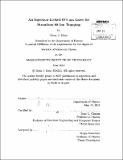An injection-locked 674 nm laser for Strontium-88 ion trapping
Author(s)
Katz, Rena J. (Rena Jenelle)
DownloadFull printable version (4.657Mb)
Other Contributors
Massachusetts Institute of Technology. Department of Physics.
Advisor
Isaac L. Chuang.
Terms of use
Metadata
Show full item recordAbstract
Energy levels of the valence electron of a single trapped ⁸⁸Sr+ ion can be harnessed as an effective qubit for quantum information processing. The qubit transition to a metastable energy state can be stimulated by a laser at a frequency of 444.779044 THz. A laser beam with higher intensity causes more rapid transitions between quantum states, and thus allows more computational operations within the coherence time of the system. The focus of this thesis is the design and construction of a more powerful laser to stimulate the qubit transition of the 88Sr+ ion, using injection-locking to stabilize the frequency of the new laser. Injection-locking is a technique for using an existing, stable laser to control the frequency of a second laser diode. A small amount of input power is enough to produce a much more powerful output beam at the same frequency, so the system acts as an amplifier. We found that a AlGaInP laser diode required 9 +/- 2 pW of injected input power to lock to the input frequency, producing an output power of 11.56 +/- 0.31 mW. The ratio of input to output power was (7.8 +/- 1.7) x10-⁴. The injection-locking frequency range was 18.4 +/- 1.6 MHz.
Description
Thesis (S.B.)--Massachusetts Institute of Technology, Dept. of Physics, 2012. Cataloged from PDF version of thesis. Includes bibliographical references (p. 45-47).
Date issued
2012Department
Massachusetts Institute of Technology. Department of PhysicsPublisher
Massachusetts Institute of Technology
Keywords
Physics.